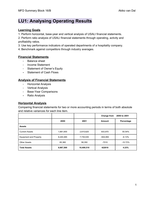MFD Summary Block 16/B Akiko van Dal
LU1: Analysing Operating Results
Learning Goals
1. Perform horizontal, base-year and vertical analysis of USALI financial statements.
2. Perform ratio analysis of USALI financial statements through operating, activity and
profitability ratios.
3. Use key performance indicators of operated departments of a hospitality company.
4. Benchmark against competitors through industry averages.
Financial Statements
- Balance sheet
- Income Statement
- Statement of Owner’s Equity
- Statement of Cash Flows
Analysis of Financial Statements
- Horizontal Analysis
- Vertical Analysis
- Base-Year Comparisons
- Ratio Analysis
Horizontal Analysis
Comparing financial statements for two or more accounting periods in terms of both absolute
and relative variances for each line item.
Change from 20X0 to 20X1
20X0 20X1 Amount Percentage
Assets
Current Assets 1,681,655 2,615,625 933,970 55.54%
Equipment and Property 8,240,485 7,735,535 -504,950 -6.13%
Other Assets 65,360 58,350 -7010 -10.72%
Total Assets 9,987,500 10,409,510 422010 4.23%
1
,MFD Summary Block 16/B Akiko van Dal
Vertical Analysis
Analysis of individual financial statements by reducing financial information to percentages
(income statement: as % of total revenue, balance sheet: as a % of total assets)
Common Size
20X0 20X1 20X0 20X1
Assets
Current Assets 1,681,655 2,615,625 16.84% 25.13%
Equipment and Property 8,240,485 7,735,535 82.51% 74.31%
Other Assets 65,360 58,350 0.7% 0.06%
Total Assets 9,987,500 10,409,510 100.00% 100.00%
Base Year Comparison
An analysis that uses a base period as a starting point (set at 100%) and comparing all
subsequent periods with the base.
20X0 20X1 20X2 20X0 20X1 20X2
Assets
Current Assets 1,681,655 2,615,625 2,877,188 100.00% 155.5% 171.2%
Equipment and Property 8,240,485 7,735,535 8,509,089 100.00% 93.9% 103.8%
Other Assets 65,360 58,350 64,185 100.00% 89.3% 98.2%
Total Assets 9,987,500 10,409,510 11,450,461 100.00% 104.3% 114.6%
Financial Position
The status of the assets, liabilities and owner’s equity (and their interrelationship) of an
organisation, as reflected in its financial statements. Also called financial condition.
Financial Position Ratios
1. Accounts Receivable Turnover = Total Revenue / Average Accounts Receivable
2. Average Collection Period = 365 / Accounts Receivable Turnover
3. Working Capital Turnover = Total Revenue / Average Working Capital
4. Average Occupancy Per Room = Number of Guests / Rooms Occupied by Guests
5. Inventory Turnover = Cost of Food Used / Average Inventory
6. Paid Occupancy Percentage = Paid Rooms Occupied / Rooms Available for Sale
2
,MFD Summary Block 16/B Akiko van Dal
Financial Leverage
The degree to which an investor or business is utilizing borrowed money.
Advantage: Can increase the shareholders return on their investment and often there are tax
advantages associated with borrowing.
Disadvantage: Companies that are highly leveraged may be at risk of bankruptcy if they are
unable to make payment on their debt; they may be also unable to find new lenders in the
future. E.g.:
- The company requires 500 in capital structure
- Two options are considered for the capital structured
1. 20% debt and 80% equity - Low financial leverage
2. 80% debt and 20% equity - High financial leverage
- The company operates in a volatile market
↳ During “good” years the company generates a EBIT of 100
↳ During “average” years the company generates a EBIT of 60
↳ During “bad” years the company generates a EBIT of 10
The company wants to maximise Return on Equity = Net Income / Equity
Capital Structure - The way a corporation finances its assets through a combination of equity,
debt or hybrid securities
- Two options for capital structure: Low debt (20%) or high debt (80%)
- Interest rate is 10%, tax rate is 30%
- Three scenarios: Strong EBIT (100), average (60), or weak (10)
Strong EBIT Average EBIT Weak EBIT
Rate Low High Leverage Low High Low High
Leverage Leverage Leverage Leverage Leverage
Debt 100 400 100 400 100 400
Equity 400 100 400 100 400 100
EBIT 100 100 60 60 10 10
Interest 10% 10 40 10 40 10 40
EBT 90 60 50 20 0 -30
Tax 30% 27 18 15 6 0 0
Net Income 63 42 35 14 0 -30
ROE 15.75% 42% 8.75% 14% 0% -30%
Concept of earnings
1. EBITDA = Earning Before Interest, Taxes, Depreciation, and Amortization
2. EBIT = Income Before Interest and Tax
3. EBT = Earnings Before Tax
4. IN = Net Income
3
, MFD Summary Block 16/B Akiko van Dal
Operating Leverage
The measurement of the degree of which a firm or project incurs a combination of fixed and
variable costs. A business that makes sales providing a very high gross margin and fewer fixed
and variable costs has much leverage. The higher the degree of operating leverage, the
greaters the potential danger from forecasting risk, where a relatively small error in forecasting
sales can be magnified into large errors in cash flow projections.
Operating Results Ratios
1. Profit Margin = Net Income / Total Revenue
2. Operating Efficiency Ratio = GOP/ Total Revenue
3. Return on Owner’s Equity = Net Income / Average Owner’s Equity
4. Sales Mix % = % of total revenue of each department
5. RevPAR = Rooms Revenue / Available Rooms
6. RevPAC = Total Revenue from hotel guests / Total Guests
7. Cost Percentage = Cost of Food Sold / Food Sales
4





